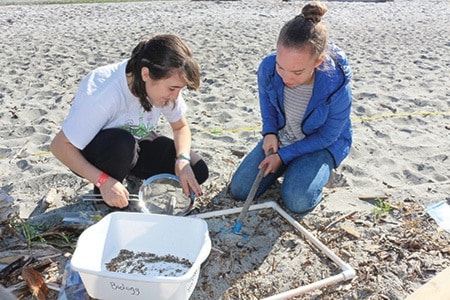Cadboro Bay is at higher risk of marine debris than some other nearby beaches, says a group of students from Oak Bay High and Maurick College in the Netherlands.
The Dutch students were on hand as part of an ongoing cultural exchange surrounding water studies.
Last June, the students who graduate this June headed overseas for the Water is Life conference that drew together hundreds of students from around the globe.
They presented information on their previous study, Bowker Creek.
Last month, they gathered with their peers from Maurick College to present information gathered for a new study the younger students hope to present at Water is Life 2018.
During a presentation for a small crowd of parents, teachers, school officials, Oak Bay Mayor Nils Jensen and Oak Bay-Gordon Head MLA Andrew Weaver, students outlined the methods used for gathering information on plastic pollutants plucked from area beaches.
“An important aspect of the scientific project involves a presentation of the background, analysis and conclusions of the student research,” said teacher Derek Schrubsoles.
The students analyzed levels of plastics at Willows beach and Cadboro Bay to compare to French Beach and Mystic Beach.
“This project like many others started with a research question,” said Sarah Polvi.
“How does the amount of marine debris compare between beaches with different levels of human impact and different wave exposures?”
They found that more human activity has a greater impact because of waste left behind and constant intervention and interruption of ecosystems.
“When we are less active it has less of an impact and this increases the lifespan of animals and plants as well, and overall just gives us a more stable environment,” said Polvi.
They found beaches with less wave exposure had less plastic and less access to open ocean and less debris.
“Beaches with more exposure have almost direct access with open ocean which allows a lot of plastics to constantly float in and out and also disturb the environment.”
They also outlined the method of sampling, from creating grids, to showcasing the size of sifting tools and the process of taking the trash back to Oak Bay High for weighing.
Final results showed Cadboro Bay held the highest level of plastic pollutants with 53.4 per cent of the weight, Willows beach had 20.2 per cent, Mystic Beach at 21.2 per cent and French Beach a 4.7 per cent.
The pollutants found at Cadboro Bay was more than all other beaches combined.
“Although this is a small beta test you can still really tell that Cadboro Bay had far more waste than the other beaches we visited,” said Robyn Hendry, a Grade 9 student at Oak Bay High.
Students plan to return to the beaches later this year and compare results to gather more information, building on the project prior to the next Water is Life conference. The first Water is Life was held in Singapore in 2014, this year’s in The Netherlands and the 2018 is planned for Melbourne, Australia.
“Water is Life is not just about science,” said graduating student Heather Velthuis, who attended the conference. “It’s a really amazing program.”
